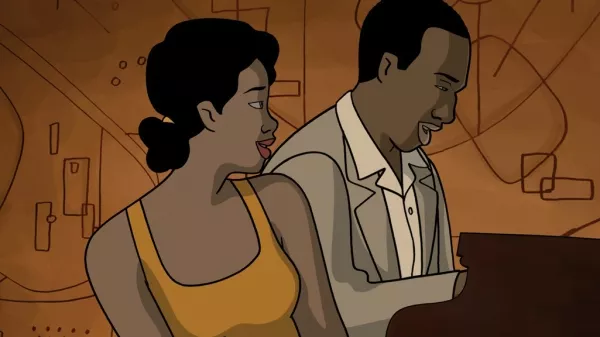
- Chico & Rita
The idea certainly isn’t one nobody has expressed before—credit to Brad Bird, on his audio commentary for The Incredibles—but I’m happy to steal it for the purposes of discussing Chico & Rita: Animation is not a genre.
It’s easy to get trapped in a mindset to the contrary, especially when thinking about feature films, since animation on American theater screens has become so connected to the idea of “family films.” Yet it’s also baffling that in an era where The Simpsons, Family Guy, South Park, Beavis & Butt-Head and so many other small-screen offerings have found success, we seem flummoxed by the notion that animation is simply a visual-art form—one that can tell a story specifically for adults just as well as for kids, the way Ralph Bakshi (American Pop) tried to do 40 years ago. No one wonders why da Vinci decided to paint the Mona Lisa rather than sculpt her, but contemporary filmmakers still have to answer “why animation.”
Filmmakers Tono Errando, Javier Mariscal and Fernando Trueba make it easy to ignore that question with their story that opens in contemporary Havana, with an aging Cuban shoeshine man growing nostalgic as he listens to an old song on the radio. In flashback, we see the old man as young Chico (Eman Xor Oña), a jazz pianist and aspiring songwriter out on the town in pre-Castro 1948 Havana with his best friend, Ramón (Mario Guerra). At one club, he spots singer Rita (Limara Meneses), and becomes instantly infatuated. He wants her to sing his entry in a songwriting contest—but professional collaboration could be complicated by personal attraction.
For purely pragmatic reasons, it’s easy to see why animation might have been a smart choice for this story. Trueba and company re-create their period-piece settings—also including 1950s New York City and Las Vegas—with wonderful precision, which might have been prohibitively expensive in live action. They send Chico and Rita on a lively car chase from Rita’s jealous boyfriend through Havana’s streets, and do so with more energy and continuity than most conventional action filmmakers. And it’s a useful fringe benefit that when spreading a narrative over 50 years, we don’t have to see our young stars in unconvincing old-age makeup. While there are occasional bits of stylized animation—like turning Chico’s arrival in New York City into an homage to On the Town, or including a Hollywood-inspired dream sequence into a parade of vintage movie stars—drawing this story isn’t about allowing the creation of the unreal. It’s about re-creating a different reality, and doing so with style.
“Reality” in this case includes nudity and sex—so if the idea of having such subject matter in a “cartoon” freaks you out, kindly find your way to the nearest exit. While it’s far from a major part of the story, the earthy and physical relationship between Chico and Rita certainly pops up over the decade-spanning story, adding to the live-wire energy provided by the bebop score. Chico & Rita doesn’t seem to think it’s at all weird to consider the possibility that an animated film could be sexy—and when Rita dances for Chico early in the film, you might wonder if a hand-drawn lady since Jessica Rabbit has had this much va-va-voom.
There is something about this particular animation style, admittedly, that results in a distance from the characters. The plot involves some familiar elements of star-crossed romance mixed with show-biz melodrama as Rita’s career moves on to movies, yet there’s never exactly what you’d call “chemistry” if you were watching a love story between two live-action actors. There’s also an attempt to introduce the racism of the era that allowed dark-skinned singers and musicians to perform at places where they weren’t welcome as customers, but the effort feels like an awkward “Oh yes, and this also happened” footnote rather than a fully integrated part of these characters’ experience.
Still, there’s something about dealing with these familiar elements in a different style that makes them feel fresh. And maybe that’s the most pragmatic reason of all for these filmmakers to create Chico & Rita in this way: It’s the one that makes us sit up and pay attention.
CHICO & RITA
![]()
Limara Meneses, Eman Xor Oña, Mario Guerra
Not Rated